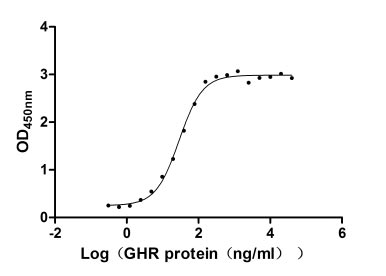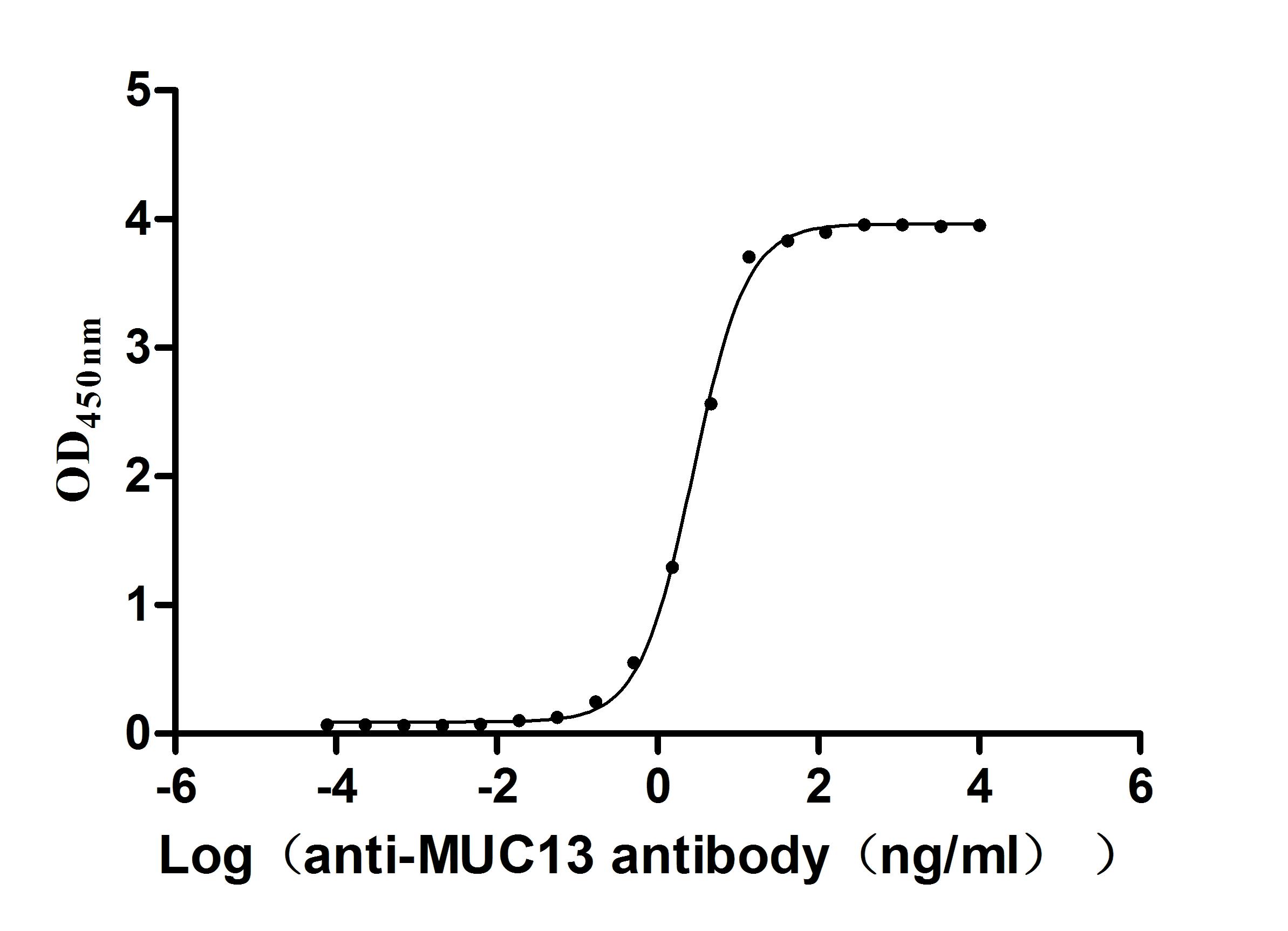Recombinant Human Inositol polyphosphate multikinase (IPMK)
-
货号:CSB-YP011774HU
-
规格:
-
来源:Yeast
-
其他:
-
货号:CSB-EP011774HU
-
规格:
-
来源:E.coli
-
其他:
-
货号:CSB-EP011774HU-B
-
规格:
-
来源:E.coli
-
共轭:Avi-tag Biotinylated
E. coli biotin ligase (BirA) is highly specific in covalently attaching biotin to the 15 amino acid AviTag peptide. This recombinant protein was biotinylated in vivo by AviTag-BirA technology, which method is BriA catalyzes amide linkage between the biotin and the specific lysine of the AviTag.
-
其他:
-
货号:CSB-BP011774HU
-
规格:
-
来源:Baculovirus
-
其他:
-
货号:CSB-MP011774HU
-
规格:
-
来源:Mammalian cell
-
其他:
产品详情
-
纯度:>85% (SDS-PAGE)
-
基因名:
-
Uniprot No.:
-
别名:3; 4; 6-tetrakisphosphate 5-kinase; Inositol 1; Inositol 1,3,4,6 tetrakisphosphate 5 kinase; Inositol polyphosphate multikinase; Ipmk; IPMK_HUMAN
-
种属:Homo sapiens (Human)
-
蛋白长度:Full Length of Mature Protein
-
表达区域:2-416
-
氨基酸序列ATEPPSPLR VEAPGPPEMR TSPAIESTPE GTPQPAGGRL RFLNGCVPLS HQVAGHMYGK DKVGILQHPD GTVLKQLQPP PRGPRELEFY NMVYAADCFD GVLLELRKYL PKYYGIWSPP TAPNDLYLKL EDVTHKFNKP CIMDVKIGQK SYDPFASSEK IQQQVSKYPL MEEIGFLVLG MRVYHVHSDS YETENQHYGR SLTKETIKDG VSRFFHNGYC LRKDAVAASI QKIEKILQWF ENQKQLNFYA SSLLFVYEGS SQPTTTKLND RTLAEKFLSK GQLSDTEVLE YNNNFHVLSS TANGKIESSV GKSLSKMYAR HRKIYTKKHH SQTSLKVENL EQDNGWKSMS QEHLNGNVLS QLEKVFYHLP TGCQEIAEVE VRMIDFAHVF PSNTIDEGYV YGLKHLISVL RSILDN
-
蛋白标签:Tag type will be determined during the manufacturing process.
The tag type will be determined during production process. If you have specified tag type, please tell us and we will develop the specified tag preferentially. -
产品提供形式:Lyophilized powder
Note: We will preferentially ship the format that we have in stock, however, if you have any special requirement for the format, please remark your requirement when placing the order, we will prepare according to your demand. -
复溶:We recommend that this vial be briefly centrifuged prior to opening to bring the contents to the bottom. Please reconstitute protein in deionized sterile water to a concentration of 0.1-1.0 mg/mL.We recommend to add 5-50% of glycerol (final concentration) and aliquot for long-term storage at -20℃/-80℃. Our default final concentration of glycerol is 50%. Customers could use it as reference.
-
储存条件:Store at -20°C/-80°C upon receipt, aliquoting is necessary for mutiple use. Avoid repeated freeze-thaw cycles.
-
保质期:The shelf life is related to many factors, storage state, buffer ingredients, storage temperature and the stability of the protein itself.
Generally, the shelf life of liquid form is 6 months at -20°C/-80°C. The shelf life of lyophilized form is 12 months at -20°C/-80°C. -
货期:Delivery time may differ from different purchasing way or location, please kindly consult your local distributors for specific delivery time.Note: All of our proteins are default shipped with normal blue ice packs, if you request to ship with dry ice, please communicate with us in advance and extra fees will be charged.
-
注意事项:Repeated freezing and thawing is not recommended. Store working aliquots at 4°C for up to one week.
-
Datasheet :Please contact us to get it.
相关产品
靶点详情
-
功能:Inositol phosphate kinase with a broad substrate specificity. Phosphorylates inositol 1,4,5-trisphosphate (Ins(1,4,5)P3) first to inositol 1,3,4,5-tetrakisphosphate and then to inositol 1,3,4,5,6-pentakisphosphate (Ins(1,3,4,5,6)P5). Phosphorylates inositol 1,3,4,6-tetrakisphosphate (Ins(1,3,4,6)P4). Phosphorylates glycero-3-phospho-1D-myo-inositol 4,5-bisphosphate to glycero-3-phospho-1D-myo-inositol 3,4,5-trisphosphate. Plays an important role in MLKL-mediated necroptosis via its role in the biosynthesis of inositol pentakisphosphate (InsP5) and inositol hexakisphosphate (InsP6). Binding of these highly phosphorylated inositol phosphates to MLKL mediates the release of an N-terminal auto-inhibitory region, leading to activation of the kinase. Essential for activated phospho-MLKL to oligomerize and localize to the cell membrane during necroptosis. Required for normal embryonic development, probably via its role in the biosynthesis of inositol 1,3,4,5,6-pentakisphosphate (Ins(1,3,4,5,6)P5) and inositol hexakisphosphate (InsP6).
-
基因功能参考文献:
- Data suggest that IPMK exhibits constrained, horseshoe-shaped substrate pocket, formed from an alpha-helix, a 3(10) helix, and a recently evolved tri-proline loop; headgroups of substrates (inositol 4,5-bisphosphate and inositol 1,4,5-trisphosphate) bind in precisely the same orientation, indicative of evolutionary optimization of 3-kinase activities against both substrates. PMID: 28882892
- IPMK is a versatile regulator of nuclear signaling events. (Review) PMID: 26682649
- No IPMK mutation was found in constitutional or tumor DNA in patients with familial small-intestine neuroendocrine carcinoids. CGH array revealed recurrent chromosome-18 deletions but no alteration in the IPMK region. PMID: 27825921
- This study demonstrated that identified genetic overlap between Alzheimer Disease disease and immune-mediated diseases, implicating the HLA locus and IPMK in the pathobiology of Alzheimer Disease. PMID: 27088644
- a severe loss of IPMK in the striatum of Huntington disease patients and in several cellular and animal models of the disease, is reported. PMID: 26195796
- A hereditary form of small intestinal carcinoid associated with a germline mutation in IPMK. PMID: 25865046
- Future research should focus on the hitherto unknown non-conventional import of IPMK and the potential impact of its dysregulation on IPMK signaling pathways regulating cellular growth and proliferation. PMID: 24632208
- Knockdown of expression and/or inhibition of function of phospholipase Cgamma1, inositol polyphosphate multikinase, which generates inositol 1,3,4,5-tetrakisphosphate (InsP) and InsP, and inositol hexakisphosphate kinase 1/2 PMID: 23322705
- Our findings implicate IPMK in a transcript-selective mRNA export pathway controlled by phosphoinositide turnover that preserves genome integrity in humans. PMID: 24074953
- Results suggest that inositol polyphosphate multikinase (IPMK) acts as a transcriptional coactivator for p53 and that it is an integral part of the p53 transcriptional complex facilitating cell death. PMID: 23550211
- overview of possible roles of IPMK in regulation of metabolism: IPMK appears to mediate activation of mammalian target of rapamycin (mTOR) in response to essential amino acids. IPMK appears to mediate hypothalamic control of food intake. [REVIEW] PMID: 23050966
- Data show that inositol polyphosphate multikinase (IPMK) interacts with the nuclear receptor steroidogenic factor 1 (SF-1) and phosphorylates its bound ligand Phosphatidylinositol 4,5-bisphosphate (PIP). PMID: 22715467
- Phosphorylation of S284 by protein kinase CK2 significantly decreases nuclear targeting of IPMK in HEK-293 cells. PMID: 22718630
- cloning of a full-length 1248-bp cDNA encoding a human inositol phosphate multikinase (IPMK); localized predominantly in the nucleus when transiently expressed in mammalian cells PMID: 12027805
- the major activity of human InsP(4) 5-kinase is phosphorylation at the D-5 position [InsP(4) 5-kinase] PMID: 12223481
显示更多
收起更多
-
亚细胞定位:Nucleus.
-
蛋白家族:Inositol phosphokinase (IPK) family
-
组织特异性:Ubiquitous, with the highest expression in skeletal muscle, liver, placenta, lung, peripheral blood leukocytes, kidney, spleen and colon.
-
数据库链接:
HGNC: 20739
OMIM: 609851
KEGG: hsa:253430
STRING: 9606.ENSP00000363046
UniGene: Hs.30280
Most popular with customers
-
Recombinant Human Growth hormone receptor (GHR), partial (Active)
Express system: Mammalian cell
Species: Homo sapiens (Human)
-
Recombinant Human Tyrosine-protein kinase Mer (MERTK), partial (Active)
Express system: Mammalian cell
Species: Homo sapiens (Human)
-
Recombinant Human IGF-like family receptor 1 (IGFLR1), partial (Active)
Express system: Mammalian cell
Species: Homo sapiens (Human)
-
Recombinant Human Zymogen granule protein 16 homolog B (ZG16B) (Active)
Express system: Mammalian cell
Species: Homo sapiens (Human)
-
Recombinant Human Claudin-6 (CLDN6)-VLPs (Active)
Express system: Mammalian cell
Species: Homo sapiens (Human)
-
Recombinant Macaca fascicularis Zinc transporter ZIP6 isoform X1(SLC39A6),partial (Active)
Express system: Baculovirus
Species: Macaca fascicularis (Crab-eating macaque) (Cynomolgus monkey)
-
Recombinant Human Interleukin-12 receptor subunit beta-1(IL12RB1),partial (Active)
Express system: Mammalian cell
Species: Homo sapiens (Human)
-
Recombinant Human Mucin-13(MUC13),partial (Active)
Express system: yeast
Species: Homo sapiens (Human)






-AC1.jpg)













